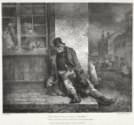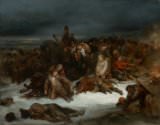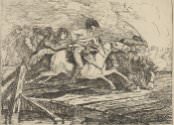Fatales consequencias de la sangrienta guerra en España con Buonaparte. Y otros caprichos enfaticos (The Fatal Consequences of Spain’s Bloody War with Bonaparte. And Other Emphatic Caprices)

Contra el bien general (Against the Common Good), plate 71 from Fatales consequencias de la sangrienta guerra en España con Buonaparte. Y otros caprichos enfaticos (The Fatal Consequences of Spain’s Bloody War with Bonaparte. And Other Emphatic Caprices), 1810–20, published as published as Los desastres de la guerra (The Disasters of War), 1863Contra el bien general (Against the Common Good), plate 71 from Fatales consequencias de la sangrienta guerra en España con Buonaparte. Y otros caprichos enfaticos (The Fatal Consequences of Spain’s Bloody War with Bonaparte. And Other Emphatic Caprices), 1810–20, published as Los desastres de la guerra (The Disasters of War), 1863. From a suite of 81 etching and aquatints, plus title page. Yale University Art Gallery, Gift of Lois Severini and Enrique Foster Gittes, B.A. 1961

Tampoco (Not [in this Case] Either), plate 36 from Fatales consequencias de la sangrienta guerra en España con Buonaparte. Y otros caprichos enfaticos (The Fatal Consequences of Spain’s Bloody War with Bonaparte. And Other Emphatic Caprices), 1810–20, published as published as Los desastres de la guerra (The Disasters of War), 1863 Tampoco (Not [in this Case] Either), plate 36 from Fatales consequencias de la sangrienta guerra en España con Buonaparte. Y otros caprichos enfaticos (The Fatal Consequences of Spain’s Bloody War with Bonaparte. And Other Emphatic Caprices), 1810–20, published as Los desastres de la guerra (The Disasters of War), 1863. From a suite of 81 etching and aquatints, plus title page. Yale University Art Gallery, Gift of Lois Severini and Enrique Foster Gittes, B.A. 1961
Fatales consequencias de la sangrienta guerra en España con Buonaparte. Y otros caprichos enfaticos (The Fatal Consequences of Spain’s Bloody War with Bonaparte. And Other Emphatic Caprices)
1810–20, published 1863
Francisco de Goya
Spanish, 1746–1828
Suite of 81 etching and aquatints, plus title page
6 1/8 x 8 1/16 in. (15.5 x 20.5 cm) (plate 36), 6 7/8 x 8 11/16 in. (17.5 x 22 cm) (plate 71)
Published as Los desastres de la guerra (The Disasters of War)
Etched in the waning years of and the years following the bloody Peninsular War (1808–14), Francisco de Goya’s Disasters of War is arguably the most epic and profound condemnation of human atrocity ever created. Deaf and in poor health, Goya began to work on the Disasters at the age of sixty-two, but the suite was not published until thirty-five years after the artist’s death. It is likely that only then was it considered politically safe to distribute a sequence of works criticizing both the occupying Bonaparte régime and the restored Bourbons.
The suite of eighty-one prints can be roughly divided into three thematic groups: the first group (plates 1–47) focuses largely on events from the war and includes gruesome scenes of garroting and dismemberment; the second group (48–64) documents the consequences of the 1811–12 famine in Madrid, before the city was liberated from the French; and the third group (65–81) is the caprichos enfaticos that equally ridicule both the Church and the French and Spanish governments—exposing their sins of gluttony, sloth, avarice, wrath, pride, lust, and envy at the expense of the Spanish people.
While the Disasters exposes the atrocities of war, its subject matter also derides the excesses of the Church, the failures of imperial ambition, and the terrible fragility of human morality during times of social and political duress. Presented here in its raw and unrelenting entirety, the Disasters remains today a hauntingly indelible indictment of human depravity.
2010.166.1.1–.81
Yale University Art Gallery, Gift of Lois Severini and Enrique Foster Gittes, B.A. 1961

![*Tampoco* (Not [in this Case] Either), plate 36 from *Fatales consequencias de la sangrienta guerra en España con Buonaparte. Y otros caprichos enfaticos* (The Fatal Consequences of Spain’s Bloody War with Bonaparte. And Other Emphatic Caprices), 1810–20, published as *Los desastres de la guerra* (The Disasters of War), 1863. From a suite of 81 etching and aquatints, plus title page. Yale University Art Gallery, Gift of Lois Severini and Enrique Foster Gittes, B.A. 1961 *Tampoco* (Not [in this Case] Either), plate 36 from *Fatales consequencias de la sangrienta guerra en España con Buonaparte. Y otros caprichos enfaticos* (The Fatal Consequences of Spain’s Bloody War with Bonaparte. And Other Emphatic Caprices), 1810–20, published as *published as Los desastres de la guerra* (The Disasters of War), 1863](https://interactive.britishart.yale.edu/sites/default/files/styles/ycba_thumbnail/public/2010%27166%271%2737.jpg?itok=F62YXr40)








